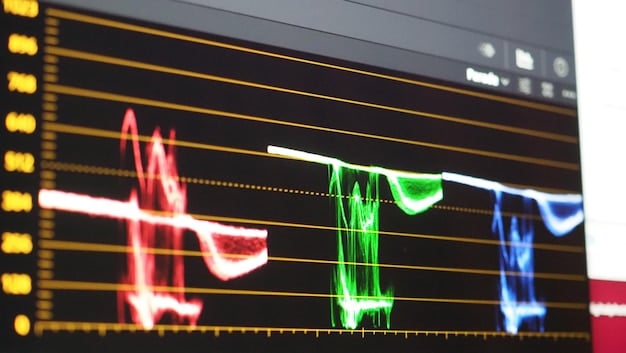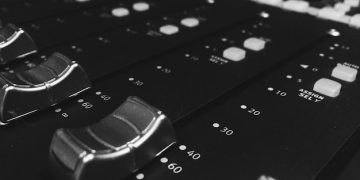Optimize Your Mix: 5 Pro EQ Techniques for Underground Rap in 2025

Optimize Your Mix: 5 Pro EQ Techniques for Underground Rap in 2025 delves into advanced equalization strategies, focusing on precision cuts, creative boosts, dynamic EQ, mid-side processing, and mastering EQ to give underground rap mixes a professional, unique edge.
Elevate the sonic quality of your underground rap tracks with cutting-edge EQ techniques designed for 2025. This guide will explore five essential strategies to optimize your mix: 5 pro EQ techniques for underground rap in 2025, ensuring your music hits harder and stands out in the crowded landscape.
Understanding EQ in Underground Rap: The 2025 Perspective
Equalization (EQ) is a cornerstone of music production, especially in underground rap. It’s not just about making things louder; it’s about sculpting frequencies to create space, clarity, and impact. In 2025, with listeners consuming music on increasingly diverse devices, mastering EQ is more critical than ever.
Why EQ Matters for Underground Rap
Underground rap often thrives on raw energy and unique sonic textures. EQ helps to enhance these qualities without sacrificing clarity or balance.
The Evolving Landscape of EQ Tools
Advanced EQ plugins now offer features like dynamic EQ, mid-side processing, and AI-assisted frequency detection.
- Precision: Pinpoint and address проблемные areas in your mix.
- Clarity: Ensure each element has its own space in the sonic spectrum.
- Impact: Make your beats hit harder and your vocals stand out.
Ultimately, understanding the role of EQ in shaping the overall sound is crucial for giving your tracks the edge they need. Adjusting frequencies carefully ensures that raw energy translates into well-defined quality that makes an impact.

Technique 1: Precision Cuts for Clarity
One of the most effective EQ techniques is using precision cuts to remove unwanted frequencies. This creates space for other elements in the mix, improving clarity and preventing muddiness.
Identifying Problem Frequencies
Learn how to identify frequencies that are causing issues like boominess, harshness, or muddiness in your tracks.
Using Narrow Q Cuts
Employ narrow Q (bandwidth) cuts to surgically remove проблемные frequencies without affecting neighboring frequencies.
- Low-End Rumble: Cut below 30Hz to remove unnecessary subwoofer rumble.
- Muddy Mids: Reduce frequencies around 250Hz-500Hz to clean up the low-mid range.
- Harsh Highs: Tame harshness by cutting around 2kHz-4kHz.
Mastering the art of precision cuts is essential for achieving a professional-sounding mix. By carefully removing проблемные frequencies, you can create a cleaner, more balanced sound that allows each element to shine.
Technique 2: Creative Boosts for Character
While cutting is essential, creative boosting adds unique character to your tracks. Emphasizing certain frequencies can bring out the distinctive qualities of your sounds.
Boosting Vocal Presence
Increase vocal clarity and presence by subtly boosting frequencies around 3kHz-5kHz.
Enhancing Snare Crack
Add more snap and energy to your snare by boosting around 5kHz-7kHz.
However, avoid over-boosting. Small adjustments of 1-3dB can make a significant difference. Always listen in context to ensure the boosts complement the overall mix.
Creative boosting is an art form that can greatly enhance the distinctive qualities of your tracks. However, it takes careful attention to prevent over-boosting. Ensure that all adjustments complement the overall mix.

Technique 3: Dynamic EQ for Control
Dynamic EQ responds to the audio signal in real-time, applying EQ adjustments only when needed. This technique is invaluable for controlling проблемные frequencies that vary in intensity.
Setting Thresholds and Ratios
Learn how to set appropriate thresholds and ratios to control the dynamic EQ’s response.
Using Sidechaining
Employ sidechaining to trigger dynamic EQ adjustments based on other elements in the mix, creating rhythmic effects.
- De-Essing: Reduce harsh sibilance in vocals by applying dynamic EQ to the sibilant frequencies.
- Controlling Boomy Bass: Reduce excessive bass frequencies only when they become overpowering.
- Transient Shaping: Enhance the attack of drums and percussion by using dynamic EQ to boost transient peaks.
Dynamic EQ is a powerful tool for addressing specific issues only when they arise, ensuring a balanced and polished sound.
Technique 4: Mid-Side (M/S) Processing for Width
Mid-Side (M/S) processing allows you to EQ the mid (center) and side (stereo) channels separately. This widens stereo width and improves the spatial imaging of your mix.
EQing the Mid Channel
Focus on the frequencies in the mid channel to enhance the center image and improve clarity.
EQing the Side Channel
Targeting the side channel with EQ can add width and airiness to your mix.
- Boosting High Frequencies on Sides: To add air and openness to the stereo image.
- Cutting Low Frequencies on Sides: To tighten the low-end and reduce muddiness in the stereo field.
- Enhancing Vocal Presence in Mid: To ensure the vocal remains clear and focused in the center.
M/S processing opens up new dimensions in your mix, allowing for precise control over the stereo image. By carefully EQing the mid and side channels, you can create a wider, more immersive soundscape.
Technique 5: Mastering EQ for Polish
Mastering EQ is the final touch you apply to the entire mix to give it a polished, professional sheen. It should be subtle and used sparingly to enhance what is already there.
Subtle Adjustments
Make small, broad adjustments across the frequency spectrum to improve the overall balance.
Using High-Shelf Filters
Apply a gentle high-shelf boost to add air and sparkle to the mix.
- Adding Air: Boost high frequencies (10kHz and above) for a brighter, more open sound.
- Enhancing Low-End: Subtly boost low frequencies (around 60Hz) for added warmth.
- Refining Mids: Make small cuts or boosts in the mid-range to balance the overall sound.
Mastering EQ is about finesse. Small changes significantly impact the final product, ensuring it sounds its best on all playback systems.
| Key Point | Brief Description |
|---|---|
| ✂️ Precision Cuts | Remove проблемные frequencies for clarity. |
| ✨ Creative Boosts | Enhance character through targeted frequency boosts. |
| 🎛️ Dynamic EQ | Manage frequencies that vary with the signal. |
| 🔊 M/S Processing | Widen stereo width by EQing mid and side channels separately. |
FAQ
▼
EQ allows you to shape the sonic landscape of your tracks, ensuring each element has its place while enhancing the roughness and authenticity of the genre.
▼
Precision cuts involve surgically removing problematic frequencies to improve mix clarity. This technique usually employs a narrow Q to target only the offending frequencies.
▼
Dynamic EQ changes in response to the signal, unlike standard EQ, which remains fixed. It addresses frequencies that only become problematic at certain times.
▼
M/S processing adjusts mid and side channels separately, enhancing stereo width. By controlling each channel, better spatial imaging and clarity are achieved.
▼
Mastering EQ serves as the final polish on a track, enhancing rather than fixing. Subtlety ensures it translates well across different playback systems without over-processing.
Conclusion
Mastering these optimize your mix: 5 pro EQ techniques for underground rap in 2025 will provide the tools to enhance your tracks. Use these techniques in conjunction with your artistic vision to make music that resonates and stands the test of time.





